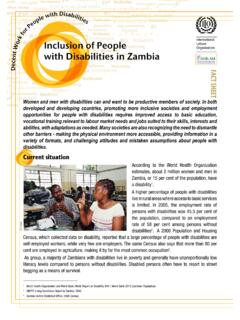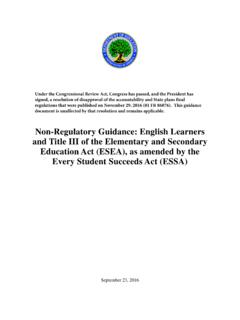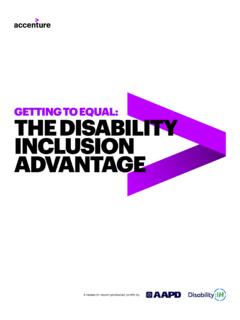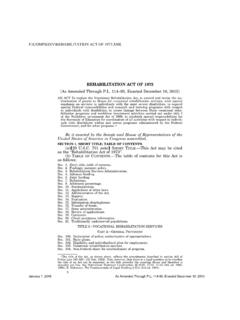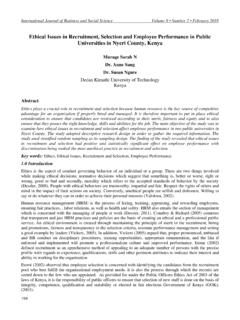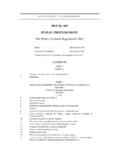Transcription of School Dropout Indicators, Trends, and Interventions for ...
1 School Dropout Indicators, Trends, and Interventions for School Counselors Donna J. Dockery Virginia Commonwealth University 2 Abstract School counselors are expected to develop programs that promote academic success for all students, including those at risk for dropping out of School . Knowledge of key indicators of potential dropouts and current trends in Dropout prevention research may assist School counselors in better understanding this complex issue. Implementing recommended intervention strategies including longitudinal tracking systems to more clearly identify students who may later drop out of School , targeted programs for use with individual and groups of students at risk of dropping out, and offering School -wide strategies may help School counselors better meet the needs of potential dropouts. 3 School Dropout Indicators, Trends, and Interventions for School Counselors School counselors strive to prepare all students for postsecondary education, work, and life after high School ; however, too many students leave School without earning a diploma.
2 Identifying students who might be susceptible to dropping out and providing appropriate Interventions to support these students are important challenges facing schools. Effective School counselors may hold key roles in Dropout prevention efforts, however, in order to support the successful retention and graduation of all students, they must have an understanding of the trends, factors, and recommended Interventions related to dropping out. The purpose of this article is to provide information regarding Dropout prevention and how counselors might best be involved in this important effort. School Dropouts: A National Concern Historically, large numbers of students dropped out of School before graduation. In the 1940s fewer than half of individuals aged 25-29 earned high School diplomas (Shannon & Bylsma, 2003). National interest in reducing Dropout rates increased after the 1950 s when earning a diploma was expected and greater numbers of students graduated.
3 Reports such as The Nation at Risk (National Commission, 1983) and the National Goals 2000 (1998) initiative raised concerns regarding Dropout rates. Legislation such as No Child Left Behind (2001), a reauthorization of the original Elementary and Secondary Education Act signed by President Lyndon B. Johnson in 1964, focused some attention on increasing graduation rates. Research regarding Dropout prevention, however, is severely underfunded compared to the federal dollars 4 allocated to increasing academic achievement. "One of the unintended consequences of the No Child Left Behind Act and its narrow emphasis on test score results was to encourage high schools to quietly ignore those dropping out or even actively push out students who would lower the test scores for which schools were being held accountable" (MacIver & MacIver, 2009, p.)
4 4). Professional School counselors roles have also evolved to reflect changes in educational systems in the United States. The Smith-Hughes National Vocational Education Act of 1917 provided initial funding for vocational guidance programs and placed the first counselors in high schools (Wright, 2012). Beginning in the 1920s School counselors expanded their role to address educational concerns and social issues, in addition to vocational preparation, an emphasis that continued through the late 1990s (Wright, 2012). The federal movement towards standards-based education resulted in statewide testing for students while No Child Left Behind requires schools and identified groups of students to meet increasing achievement standards each year. As a result, collecting, interpreting, and analyzing testing data has become an important role of School counselors (American School Counselor Association [ASCA], 2005), including comparing data disaggregated based on race and ethnicity, English language proficiency, disability, and socioeconomic status.
5 Formed in 2003, the National Center for Transforming School Counseling advocated for equal access and opportunities for all students enrolled in School (Education Trust, 2009), concepts supported by the ASCA National Model (2005). The ASCA ethical standards also require School counselors to ensure equitable 5 opportunities for all students, and to use data to help close achievement and opportunity gaps between different groups (2009). Despite these efforts, limited gains have been made towards achieving academic proficiency, and little progress has been made towards closing the achievement gap and increasing graduation rates (Wright, 2012). Annually, more than a half a million young adults drop out of high School (Dynarski et al., 2008 ). According to the National Center for Education Statistics (NCES), the national graduation rate in 2008 was about 75%, with Caucasian and Asian Americans graduating at much higher rates than their Latino, African American, and Native American peers (Stillwell, 2010).
6 Males dropped out at higher rates than females in every state and fewer students who were English language learners, had disabilities, or were from lower socioeconomic backgrounds earned diplomas (Stillwell). Despite recent efforts in improving graduation rates and reducing Dropout rates, the numbers have changed little, and determining which Interventions are most effective with different groups of students at risk for dropping out remains a challenge. According to the Alliance for Excellent Education (2009a), students who leave School without a diploma will earn a quarter of a million fewer dollars during their careers compared to high School graduates. Earnings lost due to reduced wages over their lifetime for dropouts from the class of 2008 are predicted to be more than $319 billion nationally. In addition, dropouts contribute fewer dollars to the local, state, and federal tax base and rely on public assistance and social services to a larger degree than those who graduate.
7 High School graduates report greater life satisfaction than do those who drop out of School , live an average of a decade longer, and engage in civic responsibilities such 6 as voting and volunteering at higher rates than do dropouts (Alliance for Excellent Education, 2009b). High School graduates use food stamps, public assistance, and government health care at lower rates than do dropouts. In addition, children of parents who earn diplomas are healthier and are more likely to graduate from high School than are children of dropouts. If schools are not able to significantly reduce Dropout rates in the near future, as many as 13 million students are predicted to drop out in the next decade, reducing national revenue by as much as $3 trillion (Alliance for Excellent Education, 2009b). Characteristics of Dropouts Early research focused on the characteristics of individual students who dropped out of School , including a number of demographic and social factors such as socioeconomic status, race and ethnicity, gender, and disability status.
8 Living in poverty at the elementary, middle, and/or high School levels is one of several factors significantly correlated to dropping out of School (Hammond, Linton, Smink, & Drew, 2007). Young adults aged 16 to 24 from the highest socioeconomic backgrounds are seven times more likely to have graduated than those from the lowest socioeconomic quartile. Although demographic characteristics linked with dropping out may not be altered by School efforts, these indicators can be used to identify groups of students who might be at risk for dropping out and who might benefit from services targeted to increase graduation rates (Hammond et al., 2007). While early studies focused on individual characteristics and conditions that might be used to predict which students would drop out of School (Shannon & Blysma, 2003), research has expanded to investigate additional home, community, and School -7 based factors that frequently influence graduation rates, many of which can be influenced by intervention efforts.
9 Low academic achievement, being retained or over-age, and poor attendance are significantly linked to dropping out across elementary, middle, and high School levels (Hammond et al., 2007). These factors are readily identifiable and may be targeted by Dropout prevention efforts. Students experiences in School impact whether they will graduate from high School , and academic performance and engagement in School are major indicators of potential dropouts (Hammond et al., 2007). Poor academic performance as measured by low grades, failing courses, or low test scores, is one predictor of dropping out. A number of studies have also found the combination of failing core academic classes, poor attendance, and earning poor behavioral marks from teachers linked to later dropping out of School (Balfanz, Herzog, & MacIver, 2007; Neild & Balfanz, 2006).
10 Students may also psychologically disengage from School , not expect to graduate, and lack academic plans beyond high School . In addition, disruptive classroom behaviors can indicate student disengagement. These behaviors which interrupt instruction and student learning may include impulsive actions, defying authority, arguing with peers, and/or failing to comply with School rules (Bidell & Deacon, 2010; Powell & Newgent, 2008 ). Students who exhibit disruptive classroom behaviors experience both academic and psychosocial difficulties and may strain limited School resources and services (Bidell & Deacon, 2010). Such inappropriate behaviors are occurring in School classrooms with increasing frequency, resulting in increased disciplinary referrals and lowered academic achievement (Lambert, Cartledge, & Heward, 2006). In addition, disruptive classroom behaviors have been linked with 8 dropping out and delinquency, particularly when such activities begin in primary grades (Vitaro, Brendgen, Larosse, & Trembaly, 2005).










